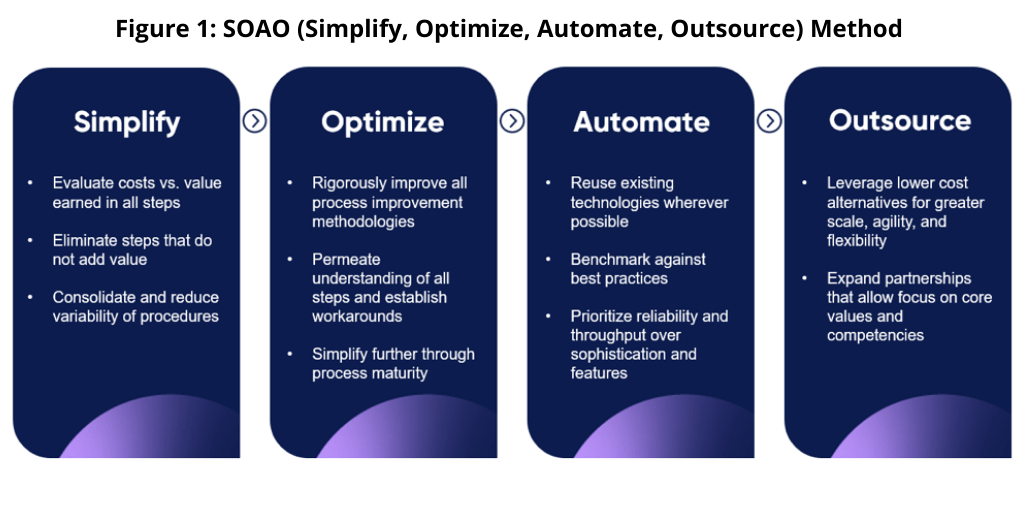Setting The Right Goals: Go Digital, Not Paperless
Digital transformation initiatives can often times result in false starts and inefficiencies by overemphasizing “paperless” environments. Such endeavors focus on identifying and converting paper-based forms and procedures to electronic means, which merely shift manual processes from pen and paper to the keyboard without resulting in any real productivity gains. True digital transformation should be focused on transforming the experience of employees to reduce complexity, is customer-centric, and optimize business processes by applying process improvement principles as a first step. This approach, backed by strong executive sponsorship, can yield maximum manpower savings and true business optimization, ultimately driving business growth and customer value.
By James Choi, Senior Vice President, Chief Information and Marketing Officer, Samsung Biologics
As businesses seek to do more with less internally and externally, digitalization initiatives are often times front and center in strategic planning and investment activities. Once revolutionary technologies such as cloud computing, SaaS, IoT, and AI are now within reach of most organizations and also fully commercialized and packaged for rapid implementation and deployment. However, this improved accessibility and plethora of solutions providers can often lead to disappointing results in the absence of a strategic approach to applying true digitalization.
A common mistake with most failed digitalization efforts is the branding and focus on “paperless,” or initiatives in which the primary metric is the elimination of paper. This in turn leads to various activities to identify paper-based forms and finding solutions to “digitalize” them into electronic workflows. One example of this is digitalizing paper-based logbooks to track asset utilization. The thinking that converting paper entries into electronic logs via a digital logbook solution will make assets easier to track is mostly correct; however, from an end-user perspective, switching manual entry via pen and paper to a keyboard and screen is only marginally more convenient. The better, more optimal approach is to analyze the actual information that is needed from the source (asset) and eliminate the need to manually collect it in the first place. By connecting the asset (a lab instrument or equipment) to a centralized system, information that would have been entered into the logbook can be collected automatically (date/time of usage, user login, asset identification, etc.), thereby obviating the need for a logbook—paper or electronic—to begin with. In this example, the digitalization initiative may require more upfront investment (network connectivity and some system interfacing), but the manpower savings multiplied across the organization will be substantially greater than the ostensible gains from going strictly paperless. A paperless environment may be achieved as a result of digitalization efforts but should not be the sole indicator of success nor the initial objective.

So, what is the right approach when embarking on digital transformation? The ideal digitalization strategy counterintuitively is to focus not immediately on the technology solution, but to begin with the existing manual processes using the SOAO (Simplify, Optimize, Automate, Outsource) method (Figure 1).
The first step in simplification is to evaluate and assess all processes and steps to ensure each is critical to quality and/or adds real value. Value in this sense should be defined in terms of whatever contributes more directly to core business objectives or customer value. In other words, the goal is to streamline all steps, procedures, and processes to maximize efficiencies in delivering customer value. Anything else should be eliminated in order to simplify the environment as much as possible. Organizations that miss this important step may end up converting nonessential forms, unused reports, and procedures to electronic versions and prolong their existence, which all lead to higher levels of complexity. Based on Quocirca’s digitalization survey (Reference 1), 62% of respondents stated that complexity is the top barrier to deploying document capture technology. In this regard, the simplification step is a great opportunity for organizations to identify and eliminate duplicate reporting and other time-wasting or non-value-added activities. According to a consultant survey of more than 200 Fortune 500 business units, more than half of all reports are used only partially (Reference 2).
The next step is to optimize all remaining and essential processes as much as possible by applying various methodologies, including Lean Six Sigma, DMAIC, SIPOC Analysis, and other tools adopted by the organization. By optimizing before automating, businesses can avoid proliferating bad processes that can create even more waste and inefficiencies. Business processes that have not been first simplified and optimized should be prevented from being digitalized, and this includes new processes that are tempting candidates to start digitally from the outset. Introducing a brand-new process digitally can sometimes work, but in many cases, end-users have to deal with constant changes and bugs if the process has not been fully refined and optimized before being digitalized.
After simplifying and optimizing the business environment, organizations can then—and ideally only then—begin to automate with digitalization. This not only ensures the maximum return on IT investments, but also reduces the dependency on subject-matter-expert (SME) resources needed during digitalization initiatives. Additionally, all automation tools or digital investments should be centrally tracked to maximize reuse and return on IT investments as much as possible. Another important facet during this step is to eliminate the need for forms or existing procedures altogether with the right IT system design and architecture as in the previous logbook example. One way to do this is to “follow the data” by thoroughly analyzing all sources of data and interfacing them to a centralized hub or data repository with time stamps so that any reports or workflows can be digitally created or triggered with minimum manual intervention, or even augmented with AI algorithms.
And finally, the last step is a longer-term strategic decision all businesses must make in the ultimate interest of its clients and shareholders. Once the business environment has been fully optimized and digitalized, what remains is to evaluate all processes to assess whether it is a core competitive differentiator or adds strategic value. Processes that are not core or have become commoditized (cloud infrastructure, for example) are ideal candidates for outsourcing. Businesses that do this well can improve not only their agility and focus, but also their cost structure and scalability by leveraging partners that can do it reliably, on time, and provide a lower total cost of ownership.
Digitalization without simplification and process optimization is a pitfall all too common for organizations seeking to modernize and innovate based on the promise of new and exciting technologies. Eliminating paper should not be the core goal, but rather a result of true business optimization through digitalization. And if done right, digital transformation will result in: (1) faster access to the right information when needed; (2) improved productivity; (3) data-driven, AI-assisted decision-making; and (4) improved employee experience and customer value to ultimately drive business growth and innovation. That said, the success of any business endeavor, including digitalization, requires strong organizational leadership, including executive level understanding, alignment, and sponsorship. Top-level leadership must reinforce the right metrics and longer-term strategic outcomes in order to successfully advance the organization into the digital era for its clients and shareholders.
References
1. Quocirca, “The Road to Digital Transformation.”
2. The Lab Consulting, “How to Vanquish Management Report Mania.”
ABOUT THE AUTHOR: James Choi, Senior Vice President, Chief Information and Marketing Officer, Samsung Biologics
James Choi is a Senior Vice President and Chief Information and Marketing Officer at Samsung Biologics. With over 25 years of organizational leadership experience in the healthcare and informatics industries, he also spearheads the company’s Investor Relations and Global Public Relations.
Prior to joining Samsung Biologics in 2014, Mr. Choi held various technology and operations leadership positions at major global healthcare and informatics corporations. Mr. Choi began his career with Philips Healthcare in 1989 as Site Planning Manager and advanced through leadership positions in Customer Service eBusiness and Technology, Operations, and Information Systems for North America. Mr. Choi then transitioned to the Informatics and Security industry and was CIO for a major background investigations, insurance intelligence, and commercial pre-employment screening company. Mr. Choi most recently served as CIO for Beckman Coulter’s Clinical Diagnostics and Life Sciences companies.
Mr. Choi received his bachelor’s degree in Mechanical Engineering from UC Irvine and an MBA from the Marshall School of Business at the University of Southern California.


